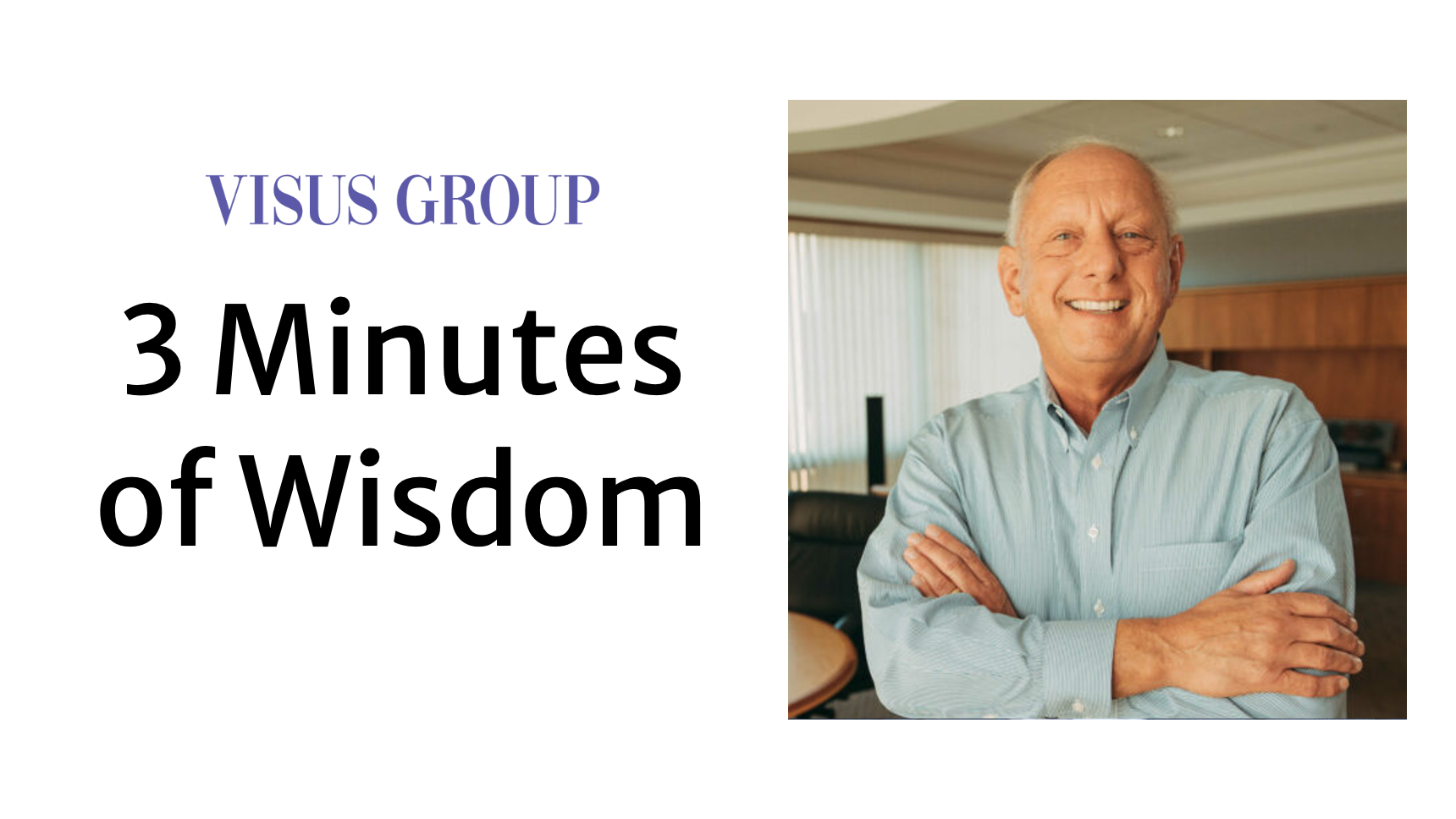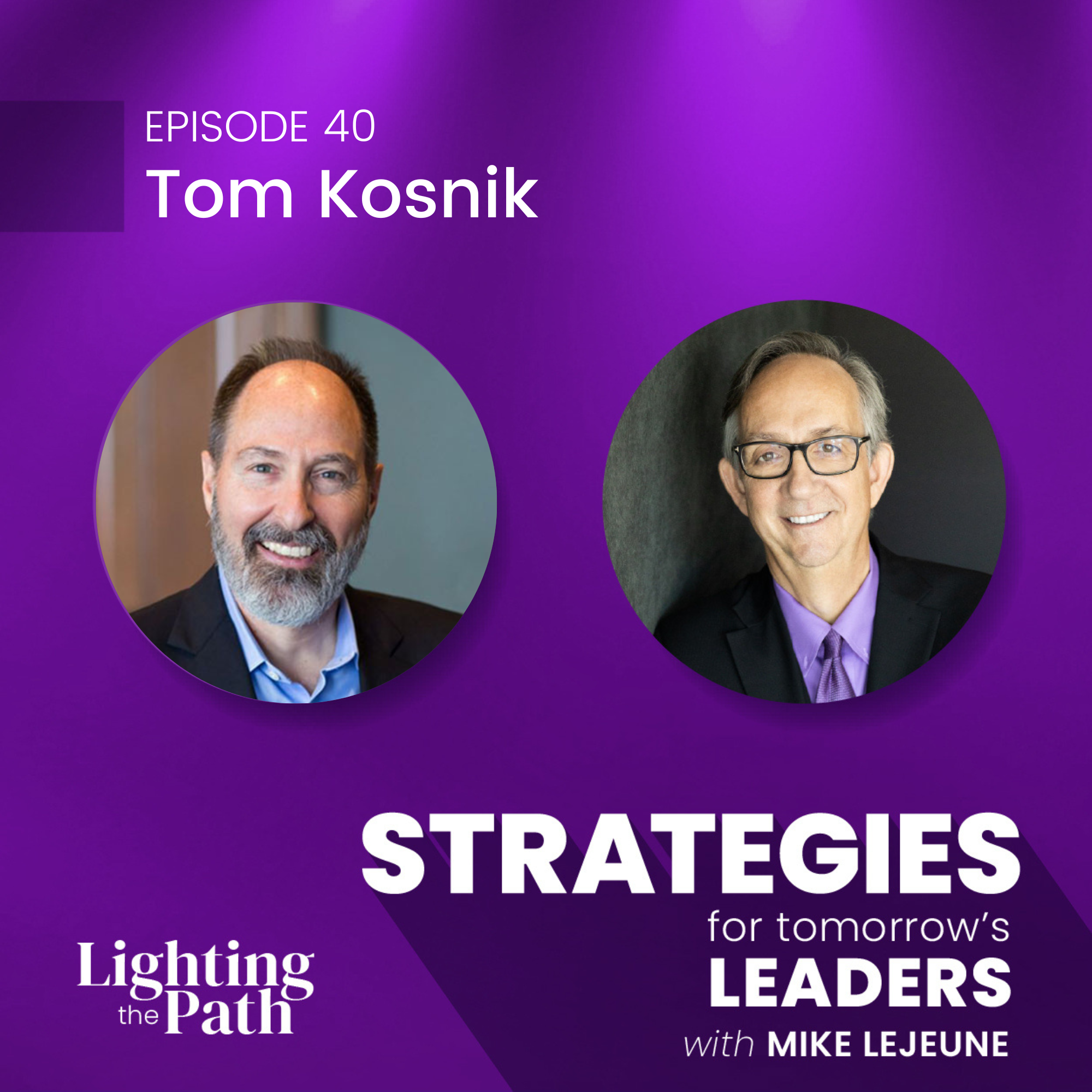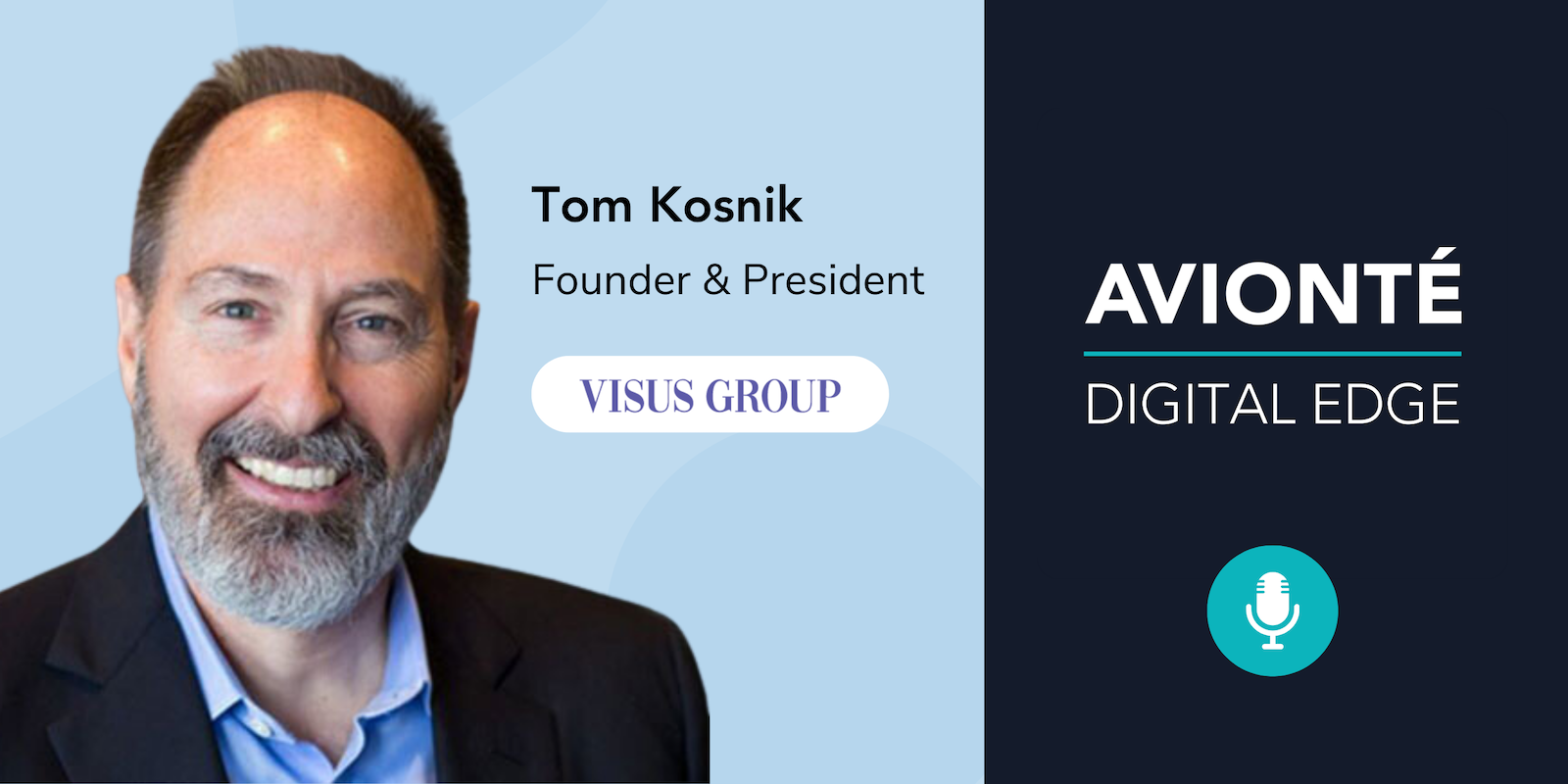From one office and one employee to 100 offices and 400 employees. Rene Poch, Founder of Trillium Staffing, talks about how he built leaders who truly run the business units for him.
Continue readingPart 1: The Key for Scaling Your Company to the Next Level
With an insightful view of the recruiting industry, Tom delved into the challenges facing leaders in scaling their businesses.Tune in to explore Tom's invaluable insights on scaling businesses to new heights and unlocking the potential for sustainable growth.
Continue readingTom Kosnik, On Forging Next-Gen Success in Staffing Leadership
What strategies can staffing leaders use to effectively engage with this new generation of workers? And how can we provide them with the necessary support to ensure their success as the upcoming leaders in this field? To help shed light on these questions, Christopher Ryan, Chief Marketing & Strategy Officer at Avionté, sits down with Tom Kosnik, President of Visus Group, LLC.
Continue readingThere are Good Things in the Short Straw
Tom Kosnik, President of Visus Group and Founder of Presidents' RoundTable, says he got into the staffing industry because he drew the shortest straw. Now, he will be the first to laugh and tell you that this was the best thing for him. Tune in as he and Lisa discuss the intersection of community and entrepreneurship, as well as the importance of examining your blind spots for business growth.
Continue readingStaffing Exclusive
Get ready to explore the shifting dynamics of staffing in today's job market. Tom's insights offer a roadmap for companies to adapt, thrive, and excel.
Continue readingHow to Build a Great Company Culture?
Todd Bavol, CEO and Co-Founder of Integrity Staffing Solution, shared a few tips in building a great culture.
Continue readingCould Marketing be More Important Than Sales? Welcome to the New World.
Let’s face it. Over the past few years, the Marketing function has become more critical to the success of a staffing company than sales. This is a bold statement, I know. A staffing company is, essentially, a sales organization so how is it that marketing has become more critical to the growth plan? Well, we’ve been hearing buzzwords like “digital transformation”, “automation”, and “social recruiting” for years now. Plus, more marketing technologies are emerging and the need to both understand and manage these platforms is becoming more important as people want to be communicated to on their terms. Throw in the pandemic accelerating all of this and now the entire selling and recruiting landscape has completely changed, not just for the staffing industry, but for all the clients as well.
The entire sales methodology has shifted. When we look at the outbound sales function, it is a state of the art website that is being recognized by the search engines that must be aligned with the sales efforts. Remember, “sales” is outbound or push-orientated and “marketing” is inbound or rather pull-orientated. It’s no doubt you have your salespeople making phone calls not really to get anyone on the phone that minute, but rather to leave a compelling commercial that will intrigue a hiring authority to explore the company further, most often driving them to their website. Once that is reviewed and the value proposition is clearly communicated, then and only then will the hiring authority reach back out to the salesperson (hopefully!). A good majority of a salesperson’s activities are now social media-related tasks whether it’s direct outreach on platforms like LinkedIn or it’s keeping in front of them via a posting schedule. And should be responsible for the execution of this sales work? The marketing leader, namely the VP of Marketing or CMO.
When we look at the recruiting function, where do I start? A marketing leader should play a huge role in the recruitment strategy in their staffing company. The marketing leader should be working with Recruiters to have a certain persona on LinkedIn and other social media platforms. Marketing should be assisting recruiters with writing job board ads to make the ads more attractive, thus acquiring a higher percentage of candidates. Marketing leaders should be working Operational leaders and IT to ensure the quality of the information in the ATS is high and work with Recruiters to more fully utilize the database for more efficient sourcing. Most importantly, marketing leadership should be managing the marketing campaigns, including candidate engagement platforms, like Sense and Herefish, and texting programs to ensure that staffing firms are getting the utilization and conversion rates from their investments.
I am just touching the surface here with the responsibilities of this VP of Marketing or CMO. I have not even addressed all the senior level executive responsibilities. Think through the sales & recruiting functions and work tasks. This marketing leader should be touching all of those responsibilities. We are even seeing our clients, who are small owner-operator businesses, hiring full-time marketing leaders to lead and manage a bulk of this work.
Guess who is managing and advising the entire company on job boards and job board usage? You guessed it, the CMO. Specific to job boards, all bets are off. First, the job board metrics are way off due to all the craziness that has been going on in the economy and the job market. Any when I say “the job board metrics are way off”, I mean that the price keeps going up and up and up and the results continue to go down and down and down. A staffing firm cannot solve this issue by thinking about and utilizing job boards the way job boards were utilized pre-pandemic. The smarter staffing firms are using programmatic advertising. And guess who on the team is figuring that all out? Again, it’s the CMO.
I have been blogging here about the Chief Marketing Officer. This title is going to be different depending upon the size of your staffing organization. It may be a Direct of Marketing or a Vice President of Marketing or a Marketing Manager. Regardless of the title, I really believe this role has become more critical to the success of a staffing firm than the Vice President of Sales. At the Visus Group, we help staffing firms figure out these functions and roles and responsibilities and work tasks to adequately respond to the rapidly changing world of selling and recruiting. Marketing has rapidly become a very critical function in most firms, but finding the right leader to take the helm can be a challenge. We can help. The last thing you want to do is find yourself behind the competition. If you’re thinking about this role or hiring a marketing leader, contact us.
How to find the right legal partner for your staffing or recruitment firm
As a business owner, it is common practice to eventually need to seek outside legal counsel or hire a law firm to represent your organization. The staffing and recruitment industry is no different. In fact, I might argue based on my nearly 30 years in the industry, that finding the right legal fit for your business is even more important given all the nuances with regards to employment law…after all, we are in the ‘people’ business. After a couple of recent experiences with my clients, I thought it would be timely to offer some advice to avoid common pitfalls when hiring legal representation.
Let’s start with a few examples where my clients were given legal advice from attorneys that did not have experience in the staffing industry.
Case Study #1
An owner of a staffing business had a solid B player that took a job with a competitor. The business owner’s attorney advised to take legal action against the employee and the competitor. I suggested going to the competitor and asking for a fee to buyout the non-compete. The non-solicitation could remain but make some money on a buyout. The pursuant owner of the staffing business spent more than $100k and lost on all counts. I don’t know if this is true, but I heard that 9 out 10 non-compete litigations go in favor of the employee. Very difficult to stop someone from making a living as a recruiter or sales executive.
Case Study #2
An owner of a staffing firm generating $8 million in annual revenue was selling the firm. The owner had a very solid offer from a very ethical staffing business that was north of $100 million in annual revenue. The structure of the deal was 70% cash at closing and 30% in an earnout. The person that was selling had an attorney that had never assisted in the sale of a staffing firm. The attorney was adamant about a “personal guarantee” from the owner of the buying firm, a staffing firm north of $100 million in annual revenue, let me remind you. There are so many other ways to guarantee such a transaction. The deal went sideways. (and then what)? Perhaps we come up with it went sideways and the buyers pulled their offer?
Paying for outside support is not usually the top choice for any business owner, however, the cost avoidance when hiring an expert, is worth it in the long run and can actually save you money in many cases. I have seen many smaller firms where they will have their CFO or HR resource review legal matters, however you have to ask yourself depending on the matter, is the risk worth it? When matters get more serious and with ever changing laws in the employment world, it is smart to engage legal support. When hiring an attorney or contracting for legal services here are a few things to consider in order to find the right fit for your business.
- Find an attorney and/or law firm that has staffing industry experience. An attorney and/or law firm that has staffing industry experience is extremely valuable. This is likely the most important criteria to use when choosing an attorney. Businesspeople not from the staffing industry look at the staffing industry as a “simple” business. Nothing could be farther from the truth. There are contracts and liabilities with buyers of staffing services. Be aware of the liability buyers attempt to push down to staffing firms. There are contracts between contractors and temporary employees as well as many legal requirements that need to be honored. Then there are internal employees with non-competes and non-solicitation agreements and compensation programs for senior level employees.
- Trust your intuition. Years ago, a client of mine taught me that you must sense that your attorney is acting in your best interest. My client told me that it is not anything logical, but rather it was more of an intuitive sense otherwise known as gut instinct. He said, “The first time you start thinking your attorney is padding the hours, then that is a sign that something is not right.” Your attorney and/or law firm needs to be a trusted advisor in which you have total and complete trust.
- One size does not fit all. Attorneys will specialize in areas of expertise such as workers compensation, mergers and acquisitions, human resources, general business, property, etc. Many small staffing firms will hire an attorney that is a “friend of a friend”. This is potentially a big mistake. Even a small staffing firm will likely need access to a handful of attorneys that specialize in various areas of specialty. One size does not fit all when it comes to legal advice. And reliably, high quality and professional legal advice is worth its weight in gold.
- The American Staffing Association (ASA) has your back. For all those that own and operate staffing firms in the United States, a quick question or inquiry to the attorneys at ASA can go a long way in getting proper guidance. I am a long-time member of the ASA and the attorneys on their staff have provided tons of high-quality advice to the Visus Group clients over the years. In addition, when I reach out to the ASA attorneys, I consistently get a professional and prompt response. Don’t forget the great resources available to you at your fingertips.
At the Visus Group we have a few alliance relationships with attorneys that have multiple years of staffing industry experience. If this is an area of concern for you or your staffing firm, feel free to reach out to us. We work with many staffing firms through our RoundTable programs who spend time addressing and discussing legal issues they are facing as well as use our program to share their networks with our members.
When it comes to technology in your staffing firm, address these five areas first.
Technology in the staffing industry sure has evolved over the last few years. Right now, there are over 400 hundred technologies that are currently supporting the staffing industry. That’s right, 400+ technologies! How do you know which ones are new? How do you know where to start? How do you know which ones are the best ones for your staffing firm?
What I frequently hear from my clients and members is this: “I’m a business owner of a staffing firm, someone with a sales background. How can I possibly know how to make the right decision on technology?” It’s a valid question and one that has a variety of answers. The first step is to really analyze where you currently are on the technology spectrum ranging from low-technology firms, a smaller firm or one that doesn’t use too many products, to an enlightened staffing firm, one that has built out their tech stack and understands how to leverage their IT department for greater efficiency. The reality is that many are on the former side.
The good news is that we are in a unique position, through our Presidents RoundTable, to get exposure to all the IT challenges that staffing firms of all sizes face on a weekly basis. Through all of these stories and consulting moments, we’ve identified five critical areas that staffing firms need to address within their IT strategy:
Align your technology stack to your business model.
What is your business model? Define it. Know it. Map it out. And then determine what is the best technology to help you implement that business model in the marketplace. The number one error we see staffing business owners make is that they get enamored with shiny new technology. Or, they hear from their Sales Reps & Recruiters, “We have to have this new technology! This new technology will be a game changer for us!”
The worst mistake you can make (as it relates to IT) is fitting the technology to your process. The replicable business model is the anchor (the key criteria) in which all decisions on technologies are judged against. It is that simple. A simple decision-making tree will help any staffing firm make far better IT decisions. And knowing what specific business model is being implemented.
Decide who will manage your technology.
The makeup of your IT department can have an enormous effect on how fast or slow you are to new technologies. There are essentially two structures – in-house IT or Outsourced.
Outsourcing: If you are a small Owner/Operator staffing business you really have no choice, but to outsource as your payroll is best served for recruiters and salespeople. In this model, you will be paying for work done, some monitoring, but you may not see the dedication this company may have to building an IT roadmap as they will be in maintenance mode for you. The key here is to find an IT Support firm that aligns with the size of your firm and has your firm’s best interest at heart.
In-house: If your firm is midsize to enterprise, then you will most likely have IT personnel on your staff. The biggest challenge here is having the right person in the right seat. When you do, they are truly your IT QB owning the roadmap, procuring powerful vendor relationships, and getting themselves involved in your business to help make your processes better through automation. On the other hand, we have seen staffing firms held hostage by in-house IT personnel that “had all the magic passwords” or were unwilling to think critically. There are a lot of fantastic IT professionals working in companies. You just want to make sure you have someone that does not put job security over the company’s best interest.
Think about your integration strategy.
Let’s be honest, there is no staffing firm 100% happy with the ATS they are currently utilizing. Every ATS has challenges, wonky processes, or lack of wish list items. Also, every ATS has challenges customizing to an individual staffing firm’s specific business model. Your business could be part of the problem. How? Let’s think about three things. (1) Not fully vetting the capabilities of the ATS to the business need. We know of several staffing firms that implemented an ATS and in less than 18 months later switched to another ATS. Why? Because they didn’t stick to their business model. Define it, know it, then go out and find the best ATS that helps you implement that business model in the marketplace. (2) No ATS will be perfect. Just accept this fact. There is a front office, middle office, and back office. The reality is that most of the ATS’ in the market are for front office needs – recruiting and sales. It is no surprise that the middleware and back office can be suspect in many ATS platforms due to their focus on candidates and placements. (3) Integrated System Versus Separate Systems: this is a very big decision. Do I have one system where my entire process is integrated or do I find a fantastic front office and then find a separate middleware technology and back-office technology that becomes semi-integrated into that fantastic front office technology? There are pros and cons to both strategies and it just matters how this works with your business model. Also, a final consideration here is identifying your subject matter experts or those super-users who will help ensure the technology is running and all are abiding by the process.
Acquire a true technology leader.
As many of you know, we sponsor peer RoundTables through the Visus Group. Over the last several years, we have been asked to start a CIO RoundTable on many occasions, but we failed to get traction from this type of RoundTable. This RoundTable was meant to provide an outlet and community for IT leaders to discuss tech stack, current trends, and product roadmaps. Why did this fail to attract a following and what information did we gather from this? Outside of a lack of demand, it told us that many staffing firms really do not have a “true” technology leader on their staff. Rather, these staffing firms had “director-level” personnel on staff focused less on strategy and more on infrastructure and tech support. Instead, the technology strategy and roadmap responsibilities fell under the COO. In my opinion, this is not the right approach for larger staffing firms. Regional and national staffing firms need a true CIO on staff because technology is transforming the staffing industry at a record pace. Having an experienced technology leader on your leadership team ensures you have someone who understands how to evaluate new technology and translate it into current processes and overall roadmap.
Secure your technology budget.
The most important part of the equation – a technology budget. When you add up your tech stack costs between servers, ATS, phone, hardware and software to run your business, it all adds up quickly! Yes, this is all part of your IT budget, but is this a true representation of your entire IT spend? And can you calculate any cost savings or ROI? Many of our clients don’t know where to start or end with budgeting and determining the true ROI (return on investment) on technology investments. Our rule of thumb is this, if you invest in innovative technology and it does not increase the average gross profit production per internal production personnel, then it must not be the right technology for your business.
Technology has become an enormous area for staffing firms to conquer with the onset of new players and the pandemic increasing the need for digital transformation. As mentioned, these are the five areas I would circulate to my leadership team if I were in your shoes at your staffing firm. How can you correctly identify the technology that will work best for your firm without sacrificing wasted investment, additional processes or underutilized platforms? This is where the Visus Group comes in. We assist staffing firms by assessing their existing tech stack and make prudent decisions which align with your business model. Don’t get caught making the wrong decision – let’s chat!
Seven Most Common Mistakes to Avoid When Making a Staffing Firm Acquisition
With over 20,000 staffing and recruitment firms in the industry, there are always mergers and acquisitions that occur. According to Duff and Phelps research 115 staffing industry M&A transactions were completed by 96 unique buyers in 2020. This was a 20% decrease from the 143 transactions completed in 2019. Strategic buyers accounted for 85% of the staffing industry acquisitions in 2020, with private equity funds (financial buyers) investing in new platform acquisitions accounting for the other 15% of transactions.
Of the 115 transactions reported in the 2020, 44 involved companies whose predominant service offering was IT staffing and/or IT consulting. Healthcare staffing is another historically attractive sector, with 16 transactions completed in 2020.
We’re seeing that in this post-Covid era, a lot of staffing firms are in the market to acquire, but unfortunately, few do it well. Buying a small competitor or acquiring in a new market to get into that market sounds fun and sexy. The fact of the matter is that there are tons of places to make mistakes, whether it be wrong fit, not enough education of the financial indicators, or just being a novice to the valuation process.
In this short blog, I am going to outline some of the common errors I see buyers making in their attempts at acquiring a small to midsize staffing firm.
- Synergy & Trust: The number one thing a buyer needs to do at the onset is to establish synergy and trust with a seller. In fact, a buyer needs to actively build synergy and trust through the entire process. Why? No seller is going to sell their company to a person or group they do not trust. It is that simple. Building trust takes time and work. I see it often overlooked.
- Breaks in Communication: No news is bad news. Setting up weekly or bi-weekly calls to stay connected, move the process along, resolve issues, establish credibility, walk through information given and received is critical to success. When there are breaks in communication a buyer is simply communicating to a seller that they are not interested. Not good.
- Lack of Flexibility: No two deals are the same. No two sellers are the same. Buyers may have a preferred way in which to acquire a company, but when buyers approach the market with a “one size fits all” strategy, specifically regarding to the way they plan on structuring the payout of the acquisition, then they are just going to leave a lot of potential deals on the table.
- Lawyers: I see this error often with new buyers. Namely, they utilize a lawyer that does not have staffing industry experience. Big mistake. A buyer’s legal provider is likely to have M&A council on staff, but how much experience does this council have in getting staffing acquisitions across the finish line. I have seen a lot of deals go sideways simply because the buyer’s lawyer did not have the expertise in staffing.
- Lack of Focus: Nail down an acquisition profile and stick to it. Yes, stick to the profile. Such a profile is going to address the issues of size, geography, staffing niche, etc. Going to the market haphazardly or “opportunistically”, as I commonly hear, is only going to set up a buyer to waste a lot of time chasing a lot of deals that are only going to get washed. Get focused and stay focused.
- Money: Get the money lined up and secured. To start looking for acquisitions prior to having a bank on board and money lined up is only going to delay the process of acquiring a company. It is also going to communicate red flags to a seller. Most sellers will require “proof of funds”. The point here is to get your bank on board on the front end prior to going to the market.
- Not Using a Cultural Assessment: This is so effective in understanding if an acquisition is going to be a good fit. Find a tool or hire a consultant to conduct a cultural assessment on the buyer. Understand the buyer’s cultural preferences. Survey the potential acquisition using the same cultural tool. Determine if the acquisition target has cultural preferences that match the buyers. If a buyer acquires a firm where there is not a good match, post-acquisition is going to be ugly.
Here are just seven points here where buyers make common mistakes when acquiring companies, but there are many more. I will tell you, if you want to lose a lot of money, go do an acquisition without the appropriate assistance.
Here at the Visus Group we have 75+ staffing firms in our RoundTable program and over half of these members are actively seeking acquisitions. If you are looking to get orientated into doing acquisitions, think about our advisory services or joining a RoundTable and learning from staffing firms that have a track record of successfully getting deals done.










